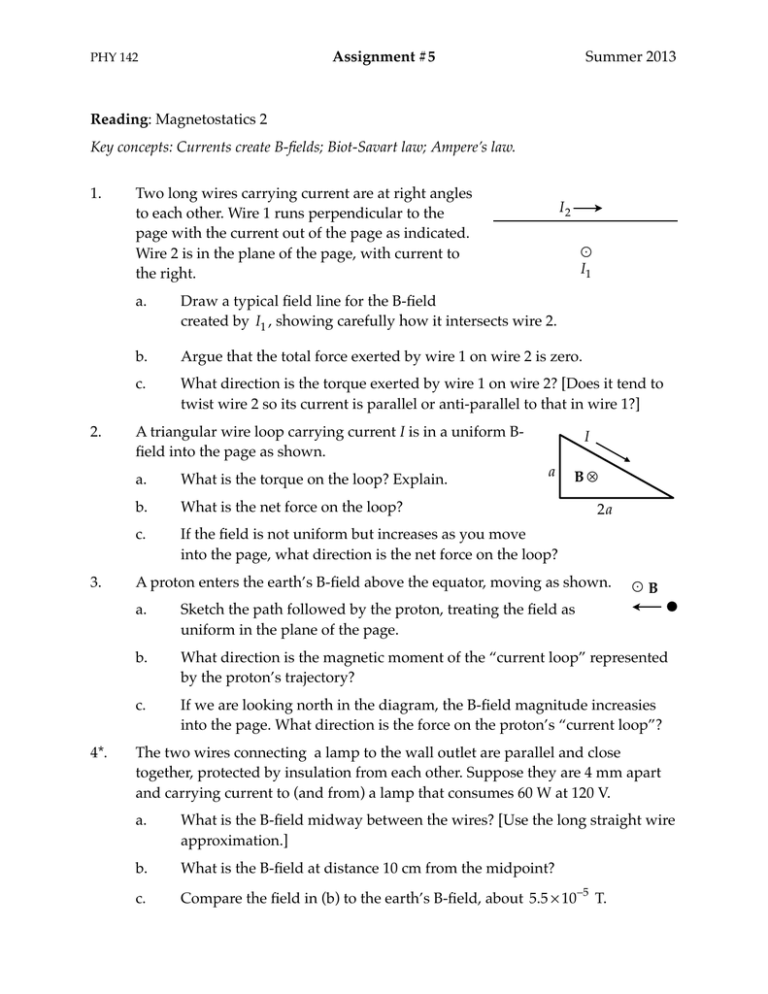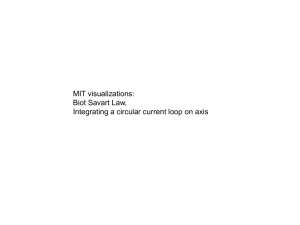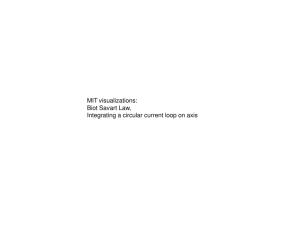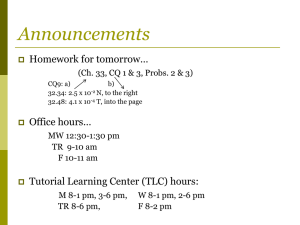Assignment #5 Reading ! Summer 2013
advertisement

PHY 142! Assignment #5! Summer 2013 Reading: Magnetostatics 2 Key concepts: Currents create B-fields; Biot-Savart law; Ampere’s law. 1.! 2.! 3.! 4*.! Two long wires carrying current are at right angles to each other. Wire 1 runs perpendicular to the page with the current out of the page as indicated. Wire 2 is in the plane of the page, with current to the right. I2 I1 a.! Draw a typical field line for the B-field created by I1 , showing carefully how it intersects wire 2. b.! Argue that the total force exerted by wire 1 on wire 2 is zero. c.! What direction is the torque exerted by wire 1 on wire 2? [Does it tend to twist wire 2 so its current is parallel or anti-parallel to that in wire 1?] A triangular wire loop carrying current I is in a uniform Bfield into the page as shown. I a a.! What is the torque on the loop? Explain. b.! What is the net force on the loop? c.! If the field is not uniform but increases as you move into the page, what direction is the net force on the loop? B⊗ 2a A proton enters the earth’s B-field above the equator, moving as shown. B a.! Sketch the path followed by the proton, treating the field as uniform in the plane of the page. b.! What direction is the magnetic moment of the “current loop” represented by the proton’s trajectory? c.! If we are looking north in the diagram, the B-field magnitude increasies into the page. What direction is the force on the proton’s “current loop”? The two wires connecting a lamp to the wall outlet are parallel and close together, protected by insulation from each other. Suppose they are 4 mm apart and carrying current to (and from) a lamp that consumes 60 W at 120 V. a.! What is the B-field midway between the wires? [Use the long straight wire approximation.] b.! What is the B-field at distance 10 cm from the midpoint? c.! Compare the field in (b) to the earth’s B-field, about 5.5 × 10−5 T. PHY 142! 5.! 6.! Assignment #5! Summer 2013 A very large number of closely spaced insulated wires carry identical parallel currents along the surface of a large flat sheet. Shown are two views, from above the sheet and from the edge of the sheet with the current coming out of the page. Each wire carries current I, and there are n wires per unit length across the sheet. I Top view I out of page Edge view a.! Consider a point above the sheet in edge view. What direction is the Bfield? How do you know? b.! Answer the same questions for a point below the sheet. c.! Use Ampere’s law with the dotted rectangle in edge view to find the formula for the magnitude of the B-field at a distance x above the sheet. As an example of the Biot-Savart law, a calculation is given in the notes (page 2 of Magnetostatics 2) of the B-field of a straight segment of wire carrying a current. a.! Does this B-field obey the field equation ∫ B ⋅ dA = 0 ? Explain how ou know. b.! Use the formula given in the notes to calculate ∫ B ⋅ dr for a circular path following the field line that passes through the field point in the diagram. sin θ1 + sin θ 2 Ans: µ0 I . 2 7.! c.! Show that this B-field violates Ampere’s law unless the wire is infinitely long. d.! The calculation in the notes is for a steady current that starts at one end of the wire and ends at the other. What fundamental law does this violate? Ampere’s law in the form ∫ B ⋅ dr = µ0I says the line integral of I A A B IB B around a closed curve is proportional to the net current passing through a surface bounded by the curve. But it does not say how to choose that surface; there are infinitely many surfaces bounded by a given closed curve. Suppose the curve in a circle, as shown. Consider the bowl in the drawing. Its rim is the circle; it bounds the surface (A) across the top of the bowl, but it also bounds the curved surface of the bowl itself (B). So both surfaces are bounded by the same circle. If we use the circle to calculate the integral on the left side of Ampere’s law, we might use either surface to calculate the current on the right side of the equation. PHY 142! Assignment #5! Summer 2013 ! a.! Let I A and IB be the currents through surfaces A and B. Argue that Ampere’s law requires I A = IB . b.! This says that the net current going into a region of space (e.g., the volume of the bowl) must always be equal to the net current leaving. Show that this requires the total charge in that region to be constant in time. [What fundamental law is involved?] c.! What does this say about the general validity of this form of Ampere’s law? Reading: Electrodynamics (to page 6) Key concepts: Displacement current; motional emf; Faraday’s law; flux rule; Lenz’s law. 8.! Refer to the previous problem and the bowl shaped surface, shown here from the side. When the displacement current I d is included in Ampere’s law, the argument used I I earlier now shows that it is the sum I + I d that must be the same entering and leaving the closed surface of the bowl. a.! The bowl surface encloses the negative plate of a capacitor being charged by the current I. Let the charge density on the plates be σ . Find the displacement current density (per unit area) between the plates in terms of dσ /dt . [What is the E-field in terms of σ ?] b.! 9.! Determine I d and show that it is the same as I. [The plates have area A.] Two circuits are arranged as shown, with coils wound the same way. The B-field in the left coil is upward within its windings. What is the direction of the current in R2 if: E R1 a.! The right circuit is moving toward the left circuit. b.! The right circuit is moving away from the left circuit. c.! The resistance of R1 is reduced. R2 PHY 142! 10.! 11*.! 12*.! Assignment #5! Summer 2013 Shown from above is a conducting bar resting on a U-shaped conductor, on which the bar can slide without friction. A uniform B-field is into the page. In a short time Δt the strength of the field is reduced to half its original value and then becomes constant at the new value. Examine each of these possibilities for the behavior of the current in the bar: B⊗ a.! During time Δt it is down the page; after that it is zero. b.! During time Δt it is up the page; after that it is zero. c.! During time Δt it is down the page; after that it is up the page. d.! During time Δt it is up the page; after that it is down the page. A small conducting loop of area A and resistance R is positioned as shown relative to a long wire carrying current I, which is increasing with time. The distance from the wire to the near side of the loop is x. Assume as an approximation that the B-field of the wire is uniform over the area of the loop. I a.! What is the induced magnetic moment, in terms of x, A, dI /dt , R and µ0 ? What is its direction? ! Ans: µ = b.! What direction is the force exerted by the wire on the loop? Explain. c.! How do your answers change if I is decreasing with time at the same rate? µ0 A 2 dI , out of the page. 2π Rx dt In the situation shown, a small bar magnet is moving downward in the region between two fixed circular loops of wire. The magnet is oriented so that its magnetic moment points downward, with field lines leaving it at the bottom and entering it at the top. Perspective view View from above a.! In the view from above, what is the direction of the current induced in the top loop? [Clockwise or counterclockwise.] Explain how you know. b.! Answer the same question for the bottom loop. c.! What direction (up or down in perspective view) is the force exerted on the magnet by the loops? Explain how you know. PHY 142! 13.! 14.! Assignment #5! Summer 2013 The diagram shows (from the side) a primitive motor, in which electromagnetic methods are used to lift a block. The conducting bar holding the block can slide freely up the vertical conducting rails. A current is passed through the bar by the battery shown; in the uniform B-field this current results in an upward force on the bar. E R B⊗ a.! What emf E0 of the battery will hold the block at rest? b.! If the block moves upward at speed v, what is the induced back emf E ′ in the circuit? c.! Taking this into account, what must be the actual emf supplied by the battery to keep the block moving at constant speed? M Let us look more closely into how the rising block gets its increase in gravitational potential energy. a.! Does it come from work done by the magnetic force acting on the bar? b.! The velocity of the charges that constitute the current will have an upward component because the bar is rising. Show that this results in a force that would reduce the current, if the battery did not supply the extra emf E ′ . d.! Show that the additional power E ′I delivered by the battery is exactly the power needed to lift the block. [Power input from a force is P = F ⋅ v .] 15.! As an approximation, we have often assumed that a static field (electric or magnetic) is uniform in the empty region between two surfaces, and suddenly drops to zero outside that region. You are to show that this behavior cannot actually occur because it violates the field equations. a.! Use Faraday’s law with the dotted path shown to prove that the E-field cannot actually drop to zero as shown. b.! Indicate on the drawing the actual behavior of the field lines near the edge of the region, and explain how this removes the contradiction with Faraday’s law.





